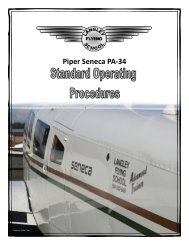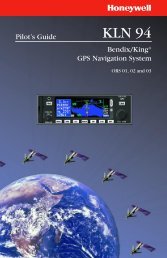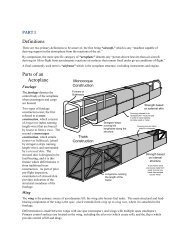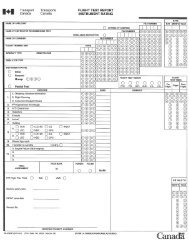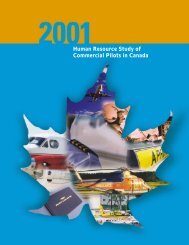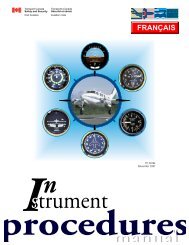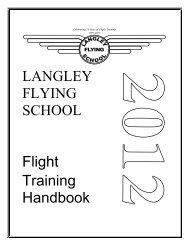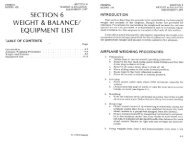Langley Flying School Private Pilot Groundschool Manual Sample ...
Langley Flying School Private Pilot Groundschool Manual Sample ...
Langley Flying School Private Pilot Groundschool Manual Sample ...
Create successful ePaper yourself
Turn your PDF publications into a flip-book with our unique Google optimized e-Paper software.
<strong>Private</strong> and Recreational <strong>Pilot</strong> <strong>Groundschool</strong> <strong>Manual</strong> Page 19<strong>Langley</strong> <strong>Flying</strong> <strong>School</strong>, Inc.The following is also required:1. 70% on Transport Canada examinations—two examinations must be written. The first examination(although order of writing is not important) is entitled SAMRA, concerns the subjects of Meteorology,Radio Aids to Navigation, and Flight Planning. The second examination is entitled SARON, whichconcerns Air Law, Aeroplane Operation and General Navigation.2. 1500 hours flight experience, of which 250 hours must be <strong>Pilot</strong>-in-command (100 of the 250 hours may beas <strong>Pilot</strong>-in-command under supervision), 6 including 100 hours cross-country flight time (which mustinclude 25 night hours).3. 100 hours night flight time as <strong>Pilot</strong>-in-command or co-pilot.4. 200 hours cross-country time as co-pilot in a two-crew aeroplane, or an additional 100 hours cross-countrytime as <strong>Pilot</strong>-in-command in addition to the above specified.5. 75 hours instrument flight time of which a maximum of 25 hours may be acquired in an approvedinstrument ground trainer (the ground trainer time cannot be applied toward the 1500 hours required).<strong>Pilot</strong> Personal LogsEvery holder of a flight crew permit, licence, or rating must maintain a personal log for the purpose of documentingexperience and recency.For each flight, this log must contain the following information:a) the date of the flight;b) the type of aircraft and its registration mark; 7c) the flight crew position in which the holder acts;d) the flight conditions with respect to day, night, VFR and IFR;e) in the case of aeroplanes, the place of departure and the place of arrival;f) all of the intermediate takeoffs and landings;g) the flight time.A pilot’s personal log is audited when a licence or rating is achieved by the pilot, and for this reason it is crucial tomake careful entries in the <strong>Pilot</strong> Log. When a commercial licence or airline transport licence is applied for, forexample, this audit of the <strong>Pilot</strong> Log is conducted by Transport Canada personnel. In the event of commercial pilottraining, it is important not to “double-dip” instrument training and night flying—that is, if a commercial student isobtaining instrument training at night, and the flight lasts .8 air time and 1.0 flight time, only a maximum of .8 canbe accredited instrument time and this has to be allocated to the <strong>Pilot</strong> Log’s “day” flight time, while the remaining .2(the difference between air and flight time) can be allocated to “night” flight time. It sounds confusing, but isrequired by Transport Canada.No person shall make an entry in a personal log unless the person is the holder of the log, or has been authorised tomake the entry by the holder of the log.Recency RequirementsFive-year RecencyThe holder of a flight crew permit, licence, or rating can only exercise the privileges of their permit, licence, orrating if they have acted as <strong>Pilot</strong>-in-command of an aircraft within the preceding five years. 8 In the event that theyhave not acted as such within this time period, privileges can only be reinstated if they undertake the following:a) successfully completes a flight review with a Flight Instructor and the Flight Instructor certifies in theholder’s personal log that the person meets the skill requirements associated with the permit, licence,6Canadian Aviation Regulation (CAR) 421.11. A complete electronic version of the CARs is available on Transport Canada’s website.7 The registration mark is the four-letter identification that appears on the wing and fuselage or tail of the aircraft.8CAR 401.05© 2012 David L. Parry



